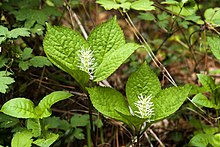Chloranthaceae
| Chloranthaceae Temporal range:
| |
|---|---|

| |
| Sarcandra glabra | |

| |
| Chloranthus fortunei | |
| Scientific classification | |
| Kingdom: | Plantae |
| Clade: | Tracheophytes |
| Clade: | Angiosperms |
| Order: | Chloranthales R.Br.[2] |
| Family: | Chloranthaceae R.Br. ex Sims[2] |
| Genera | |
| |
Chloranthaceae /ˌklɔːrænˈθeɪʃiː/ is a family of flowering plants (angiosperms), the only family in the order Chloranthales.[2] It is not closely related to any other family of flowering plants, and is among the early-diverging lineages in the angiosperms. They are woody or weakly woody plants occurring in Southeast Asia, the Pacific, Madagascar, Central and South America, and the West Indies. The family consists of four extant genera, totalling about 77 known species according to Christenhusz and Byng in 2016.[3] Some species are used in traditional medicine. The type genus is Chloranthus. The fossil record of the family, mostly represented by pollen such as Clavatipollenites, extends back to the dawn of the history of flowering plants in the Early Cretaceous, and has been found on all continents.[4]
Description
Chloranthaceae are
Differences between the genera
The four genera assigned to this family can be distinguished from each other by the following characters:
Chloranthus species are dwarf shrubs or herbaceous plants, with xylem that contains vessels. Flowers are bisexual, each of which bears three stamens on straight filaments with three anther lobes and a wide connective, and with a smooth and moist stigma. The 20 species occur in southern and eastern Asia.
Hedyosmum has separate male and female flowers. The male flowers are without bracts and have one stamen, in which the connective is not widened. The female flower is without bracts; the stigma is dry and covered in papillae. Female flowers have a 3-lobed calyx. The fruit, a drupe, has a kernel with a hard and woody shell. There are 43 species found in Latin America, including the Antilles, as well as one species found in Southeast Asia.
Taxonomy
The Chloranthaceae have been recognised as a family in most classifications but without clear relatives.
angiosperms
|
| ||||||||||||||||||||||||||||||||||||||||||
A 2004 study based on comparisons of homologous DNA fragments indicated that both the family Chloranthaceae and its extant genera Ascarina, Chloranthus, Hedyosmum and Sarcandra are probably monophyletic, with Hedyosmum being the first to diverge from the rest, and Ascarina being the sister group of the clade consisting of Sarcandra and Chloranthus. As of June 2016[update], these four extant genera are recognized, and insights into their relationships are expressed in the tree below:[5][11]
| Chloranthaceae | |
The extinct genus Chloranthistemon also belongs to this family.[12]
Historical classifications
The Cronquist system (1981) assigned the family
- to the order Piperales
- in subclass Magnoliidae
- in class dicotyledons]
- of division Magnoliophyta[=angiosperms].
- of division
- in class
- in subclass Magnoliidae
The
- in the order Magnoliales, which was assigned
- to superorder Magnolianae
- in subclass Magnoliideae [=dicotyledons],
- in class Magnoliopsida [=angiosperms].
- in subclass Magnoliideae [=dicotyledons],
- to superorder
The Dahlgren system raised the family to be
- its own order Chloranthales, which was assigned
- to superorder Magnolianae
- in subclass Magnoliideae [=dicotyledons],
- in class Magnoliopsida [=angiosperms].
- in subclass Magnoliideae [=dicotyledons],
- to superorder Magnolianae
References
- ^ "Chloranthales". www.mobot.org. Retrieved 2023-07-20.
- ^ hdl:10654/18083.
- .
- hdl:11336/136234.
- ^ a b Stevens, P.F. (2001) [onwards]. "Chloranthaceae". Angiosperm Phylogeny Website. Retrieved 2016-06-12.
- S2CID 205458714.
- S2CID 46980346.
- S2CID 91649388.
- .
- PMID 34836973.
- S2CID 84746116.
- .
External links
- Chloranthaceae in L. Watson and M.J. Dallwitz (1992 onwards) The families of flowering plants: descriptions, illustrations, identification, information retrieval. Version: 3 May 2006. https://web.archive.org/web/20070103200438/http://delta-intkey.com/.
- Andes Trees
- NCBI Taxonomy Browser
- Images of Chloranthus Flavon's art gallery: Chloranthaceae
- Image of Chloranthus oldhamii
- Image of Chloranthus serratus
- Images of Sarcandra glabra
